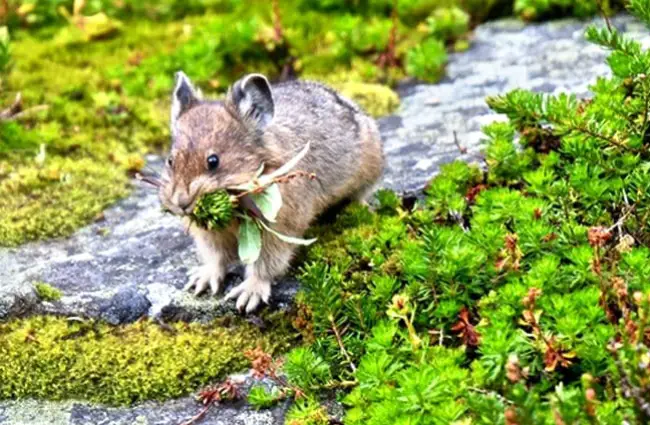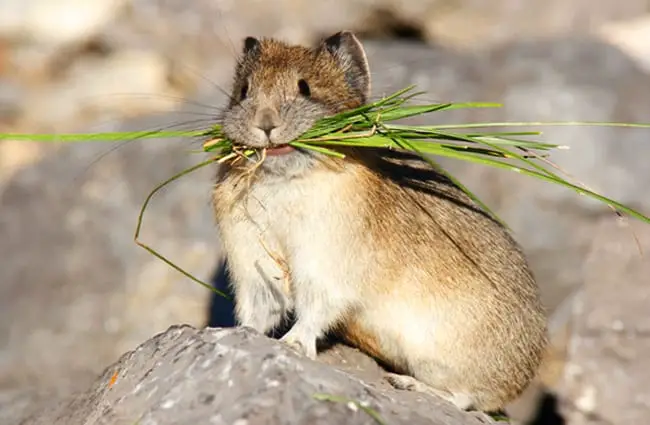Meet the Pika: A Tiny Mountain Dweller
Often described as the “whistling hare,” the pika is a small, adorable mammal found in the mountainous regions of North America and Asia. These charismatic creatures are not rodents, despite often being mistaken for them. They belong to the Ochotonidae family, making them close relatives of rabbits and hares, but distinctly different in their own right. Pikas are a fascinating subject for both casual nature enthusiasts and dedicated zoologists, boasting unique adaptations, behaviors, and ecological roles.

What Does a Pika Look Like?
Pikas are small, generally measuring between six and eight inches in length, and weighing between four and eight ounces. They have rounded ears, short limbs, and a virtually tailless body. Their coat color varies depending on the season and location, ranging from grayish brown in the summer to a lighter, more reddish hue in the winter. This seasonal camouflage is crucial for survival in their often harsh environments. They possess distinctive footpads that aid in gripping rocky surfaces.
Pika Habitats and Distribution
Pikas are highly specialized animals, thriving in cold high elevation habitats. They are primarily found in rocky slopes, known as talus, above the tree line in mountainous regions. These talus slopes provide shelter from predators, protection from the elements, and essential nesting sites. Their range extends across western North America, from British Columbia and Alberta in Canada, through the western United States, and into parts of Mexico. In Asia, several pika species inhabit mountainous regions of Russia, China, and Mongolia. They require cold temperatures and are particularly sensitive to heat.

Diet and Foraging Behavior
Pikas are herbivores, with a diet consisting of grasses, sedges, forbs, and other alpine vegetation. Unlike many herbivores, they do not hibernate. Instead, they prepare for winter by creating haypiles—carefully gathered and dried vegetation stored within their talus slopes. These haypiles serve as their primary food source throughout the long winter months. Pikas are meticulous foragers, selecting specific plants and arranging them within their haypiles to maximize storage efficiency and prevent mold growth. They are known to be selective feeders, favoring nutrient-rich plants. This caching behavior is central to their survival strategy.
Pika Life Cycle: Mating and Reproduction
Pika breeding season typically occurs in the spring and early summer. They are generally monogamous, forming pair bonds that can last for multiple years. Gestation lasts approximately 30 to 35 days, resulting in litters of two to six young, known as kits. Kits are born helpless, lacking fur and with closed eyes. They are nursed by their mother and gradually begin to explore their surroundings after a few weeks. Young pikas become independent by late summer or early fall, preparing to establish their own territories and begin the cycle anew. The survival rate of young pikas is heavily influenced by factors such as food availability, predator pressure, and weather conditions.

Ecological Role and Interactions
Pikas play a vital role in their alpine ecosystems. They are a key food source for predators such as foxes, eagles, hawks, and weasels. Their foraging activities also influence vegetation patterns, creating small openings that allow for the growth of new plants. Pikas are considered ecosystem engineers, shaping their environment through their unique behaviors. They also engage in complex communication using a variety of vocalizations, including distinctive whistles and chirps. These calls serve to warn others of danger, establish territories, and attract mates.
Pika and Humans: Historical and Contemporary Interactions
Historically, pikas have been a source of food for some indigenous cultures. Their fur has also been used for clothing and other materials. However, their relatively small size and remote habitat have limited their impact on human populations. Today, pikas are facing increasing threats from habitat loss and climate change. As temperatures rise, their high elevation habitats are becoming increasingly fragmented and unsuitable. This forces them to move to higher elevations, further limiting their range and increasing their vulnerability to predators.

Finding Pikas in the Wild
If you’re hoping to spot a pika, focus your efforts on rocky slopes and talus fields above the tree line in mountainous regions. Look for signs of their presence, such as haypiles or small rock crevices where they may be sheltering. Listen for their distinctive eek or whistle-like calls. Remember to observe them from a distance and avoid disturbing their habitat. Bring binoculars or a spotting scope for a better view. Be patient and quiet, and you may be rewarded with a glimpse of these charming creatures.
Pika Conservation Status
Several pika species are listed as Least Concern by the International Union for Conservation of Nature. However, the American pika is considered a Sensitive Species in some regions, and its populations are declining in certain areas. Climate change is the primary threat to their long-term survival, highlighting the urgent need for conservation efforts. Protecting their high elevation habitats and mitigating the effects of climate change are crucial steps in ensuring their continued existence.
For the Aspiring Zoologist: Advanced Pika Insights
Pika taxonomy remains an area of ongoing research. The number of recognized pika species varies depending on the authority, with some classifications combining closely related populations. Genetic studies are helping to clarify their evolutionary relationships and identify distinct subspecies. Pika physiology is particularly well adapted to high altitude environments. They exhibit a high metabolic rate, efficient oxygen uptake, and specialized blood characteristics that allow them to thrive in low oxygen conditions. Furthermore, their digestive systems are capable of extracting maximum nutrients from alpine vegetation.

Caring for Pikas in Captivity
Caring for pikas in captivity presents significant challenges. They are highly sensitive to temperature and stress, requiring carefully controlled environments that mimic their natural habitats. Enclosures should provide ample rocky substrate, sheltered nesting sites, and a constant supply of fresh vegetation. Diet should be carefully formulated to meet their nutritional needs, mimicking the variety of plants they consume in the wild. Regular veterinary checkups are essential to monitor their health and well-being. Enrichment activities, such as providing opportunities for foraging and exploration, can help to stimulate their natural behaviors and prevent boredom.
The pika, a testament to resilience and adaptation, continues to fascinate and inspire. By understanding their ecology, behavior, and conservation needs, we can ensure that these delightful creatures continue to thrive in the mountains they call home.

![Red Angus Closeup of a beautiful Red Angus cowPhoto by: U.S. Department of Agriculture [pubic domain]https://creativecommons.org/licenses/by/2.0/](https://animals.net/wp-content/uploads/2020/03/Red-Angus-4-238x178.jpg)




![Red Angus Closeup of a beautiful Red Angus cowPhoto by: U.S. Department of Agriculture [pubic domain]https://creativecommons.org/licenses/by/2.0/](https://animals.net/wp-content/uploads/2020/03/Red-Angus-4-100x75.jpg)

